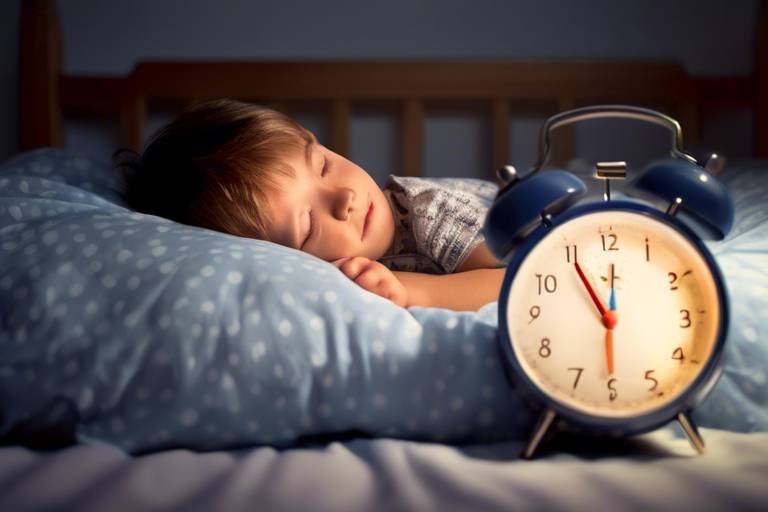Improving Sleep Habits in Children
In today's fast-paced world, ensuring that our children get the quality sleep they need can feel like a daunting task. As parents, we often juggle numerous responsibilities, and sleep sometimes takes a backseat. However, enhancing sleep habits in children is not just about getting them to bed on time; it’s about creating a nurturing environment that fosters healthy sleep patterns. Did you know that sleep is as crucial for children as nutrition? It plays a vital role in their physical growth, emotional well-being, and cognitive development. This article dives deep into effective strategies and insights that can help improve sleep habits among children, ultimately emphasizing the importance of quality sleep for their overall health and development.
Children's sleep requirements vary significantly by age, and understanding these needs is the first step toward fostering better sleep habits. For instance, infants typically need around 14 to 17 hours of sleep per day, while toddlers require about 11 to 14 hours. As children grow, their sleep needs decrease, with school-aged children needing about 9 to 11 hours and teenagers requiring around 8 to 10 hours. But why is this so important? Insufficient sleep can lead to a range of issues, from irritability and behavioral problems to long-term health complications. It's essential for parents to recognize the signs of sleep deprivation, such as difficulty concentrating or mood swings, and to take proactive steps to ensure their children are getting the rest they need.
A conducive sleep environment plays a crucial role in promoting restful sleep. Think of the bedroom as a sanctuary for sleep; it should be cozy, quiet, and dark. Factors like room temperature, lighting, and noise levels can significantly influence children's sleep quality. Ideally, the room should be kept at a comfortable temperature—around 68 to 72 degrees Fahrenheit is often recommended. Additionally, consider using blackout curtains to block out any unwanted light and a white noise machine to drown out disruptive sounds. By creating a peaceful atmosphere, you’re setting the stage for your child to drift off into a deep, restorative sleep.
Establishing a consistent bedtime routine can signal to children that it's time to wind down. Think of it as a gentle transition from the hustle and bustle of the day to the calmness of night. Effective activities to incorporate into their nightly rituals might include taking a warm bath, reading a story, or even practicing some gentle yoga stretches. These calming activities not only help children relax but also create a sense of security and predictability. When children know what to expect, they are less anxious and more likely to embrace sleep. A well-structured routine can make bedtime something they look forward to rather than resist.
Incorporating relaxation techniques such as reading, gentle stretching, or meditation can help children transition to sleep more easily. Imagine winding down after a long day with a soothing bedtime story or some quiet moments of reflection. Techniques like deep breathing exercises can also be beneficial; they help slow the heart rate and calm the mind. Encourage your child to take deep breaths, inhaling through the nose and exhaling through the mouth. This simple practice can significantly enhance their ability to relax and prepare for sleep.
In this digital age, managing screen time before bed is essential for improving sleep quality. The blue light emitted from screens can interfere with the production of melatonin, the hormone responsible for sleep. It’s advisable to limit screen time at least an hour before bedtime. Instead of scrolling through devices, consider engaging in activities that promote relaxation, such as board games or storytelling. By setting boundaries around technology use, you are not only protecting their sleep but also encouraging healthier habits.
What children eat can significantly affect their sleep patterns. It’s fascinating to consider how food can influence our sleep! For instance, foods rich in magnesium, like bananas and spinach, can promote relaxation, while those high in sugar can lead to restless nights. A balanced dinner that includes whole grains, lean proteins, and healthy fats can set the stage for a good night’s sleep. On the other hand, it’s best to avoid heavy meals, caffeine, and sugary snacks close to bedtime. By being mindful of their diet, you can help your child enjoy a more restful night.
Sleep disorders can disrupt children's sleep and overall well-being. It's crucial for parents to recognize that persistent sleep issues may require professional attention. Common sleep disorders include insomnia, which can manifest as difficulty falling or staying asleep, and sleep apnea, characterized by interrupted breathing during sleep. If your child shows signs of excessive daytime sleepiness, loud snoring, or difficulty concentrating, it may be time to consult a healthcare professional. Early intervention can lead to more effective management and a return to healthy sleep habits.
Understanding common sleep disorders is vital for parents. Insomnia and sleep apnea are just two examples, but they can have a profound impact on a child's life. Symptoms of insomnia may include:
- Difficulty falling asleep
- Frequent awakenings during the night
- Daytime fatigue or irritability
On the other hand, sleep apnea may present with symptoms such as:
- Loud snoring
- Choking or gasping during sleep
- Morning headaches
Recognizing these symptoms early can help in seeking appropriate treatment and ensuring your child gets the restorative sleep they need.
Seeking guidance from sleep specialists or pediatricians can provide tailored strategies for managing sleep issues. These professionals can offer valuable insights and recommendations based on your child's specific needs. Don’t hesitate to reach out for help if you feel overwhelmed—after all, ensuring your child has healthy sleep habits is a crucial part of their overall well-being.
Q: How much sleep does my child really need?
A: Sleep needs vary by age. Infants need 14-17 hours, toddlers 11-14 hours, school-aged children 9-11 hours, and teenagers 8-10 hours per night.
Q: What can I do if my child resists bedtime?
A: Establishing a calming bedtime routine and creating a sleep-friendly environment can help ease the transition to sleep.
Q: Are there foods that can help my child sleep better?
A: Yes! Foods rich in magnesium and tryptophan, like bananas and turkey, can promote better sleep, while sugary snacks should be avoided before bedtime.

Understanding Sleep Needs
When it comes to our little ones, understanding their sleep needs is absolutely crucial. Just like a car needs fuel to run smoothly, children require adequate sleep for their bodies and minds to function at their best. But how much sleep do they really need? Well, it varies by age, and knowing these requirements can help parents ensure their kids are getting the rest they deserve. For instance, newborns typically need around 14 to 17 hours of sleep a day, while toddlers might require about 11 to 14 hours. School-aged children usually need 9 to 11 hours, and teenagers may need around 8 to 10 hours.
But here's the kicker—what happens when they don’t get enough sleep? Insufficient sleep can lead to a host of issues, from irritability and mood swings to difficulties in concentrating at school. Imagine trying to drive a car with a flat tire; it just doesn’t work well! Similarly, children deprived of sleep may struggle with their daily activities. Research has shown that sleep deprivation can negatively impact their growth, cognitive development, and even their immune system. So, it’s not just about the hours they clock in at night; it’s about the quality of that sleep as well.
To put things into perspective, let’s take a look at the recommended sleep hours for various age groups in a simple table:
| Age Group | Recommended Sleep Hours |
|---|---|
| Newborns (0-3 months) | 14-17 hours |
| Toddlers (1-2 years) | 11-14 hours |
| Preschoolers (3-5 years) | 10-13 hours |
| School-aged (6-13 years) | 9-11 hours |
| Teenagers (14-17 years) | 8-10 hours |
As you can see, the sleep needs of children change as they grow. It's essential for parents to be aware of these requirements and to monitor their child’s sleep patterns closely. If your child is consistently waking up groggy or struggling to stay alert during the day, it might be a sign that they aren’t getting enough quality sleep. Just like we wouldn’t ignore a warning light on our car dashboard, we shouldn’t ignore the signs our children give us about their sleep health.
In conclusion, understanding your child's sleep needs is the first step towards fostering better sleep habits. By ensuring they get the recommended hours of sleep for their age group, you can help them thrive both physically and mentally. So, let's prioritize sleep—it’s not just a luxury; it’s a necessity!

Creating a Sleep-Friendly Environment
Creating a sleep-friendly environment is essential for helping children achieve restful and rejuvenating sleep. Imagine trying to relax in a noisy, brightly lit room—it's nearly impossible! The same goes for your little ones. To ensure they drift off into dreamland easily, consider the various factors in their sleeping space.
First and foremost, let's talk about room temperature. A comfortable temperature can make a world of difference. Ideally, the bedroom should be kept between 68°F to 72°F (20°C to 22°C). This range helps the body maintain its natural temperature, which is crucial for quality sleep. If it’s too warm or too cold, your child may find it difficult to settle down, tossing and turning instead.
Next up is lighting. The right amount of light can either promote sleep or disrupt it. Consider using blackout curtains to block out any outside light, especially during the summer months when the sun sets later. A dim nightlight can provide a sense of security without being too harsh. Remember, bright lights send a signal to the brain that it’s time to be awake, so keep things cozy and dim as bedtime approaches.
Now, let’s not forget about noise levels. Children are often sensitive to sounds that we adults may overlook. To create a peaceful environment, you might want to use a white noise machine or a fan to drown out any disruptive noises. This can be especially helpful if you live in a bustling area where traffic or neighbors might create disturbances. Soft, calming sounds can help lull them to sleep, much like a gentle lullaby.
Additionally, consider the bedding and furniture in the room. A comfortable mattress and soft sheets can make a significant difference in sleep quality. Ensure that the bed is just the right size for your child, allowing them to stretch out comfortably. Personalizing the space with their favorite blankets or stuffed animals can also create a sense of security and belonging, which is crucial for easing the transition to sleep.
Lastly, it's important to keep the sleeping area free from distractions. This means minimizing the presence of toys, electronic devices, and anything else that might keep your child awake. A clutter-free environment promotes a sense of calm, signaling that it’s time to rest. Consider designating a specific area for play and another for sleep, helping your child understand the difference between the two spaces.
In summary, a sleep-friendly environment is a combination of the right temperature, lighting, noise levels, comfortable bedding, and a clutter-free space. By paying attention to these elements, you’re setting the stage for your child to enjoy a night of deep, restorative sleep. Remember, a well-rested child is not only healthier but also happier, more focused, and ready to take on the day!
- How can I tell if my child's sleep environment is suitable? Look for signs of restlessness or difficulty falling asleep. If your child often wakes up during the night, it may be time to reassess their sleeping conditions.
- What should I do if my child is afraid of the dark? Consider using a nightlight or a soft glow lamp that can ease their fears while still keeping the room dark enough for sleep.
- Is it okay for my child to sleep with toys in their bed? Yes, as long as the toys are safe and not too large, they can provide comfort and security for your child.

Bedtime Routines
Establishing a consistent bedtime routine is like laying down the tracks for a smooth train ride to dreamland. When children know what to expect as they wind down for the night, it creates a sense of security and comfort, making it easier for them to transition from the buzz of the day to the calm of sleep. Think of it as a gentle nudge towards relaxation, where each activity is a stepping stone leading to a peaceful slumber.
So, what should this routine look like? While every child is unique, there are some universal activities that can work wonders. For instance, you might start with a warm bath, which not only cleanses but also relaxes tired muscles. Next, consider reading a story together. This simple act can ignite a child's imagination and foster a love for books, all while signaling that it’s time to settle down. The key here is consistency; doing these activities in the same order each night helps reinforce the routine.
Incorporating elements that promote relaxation is crucial. You could include gentle stretching exercises or a few minutes of meditation to help calm racing minds. Even simple breathing exercises can be effective. Here’s a quick method: have your child inhale deeply for four counts, hold for four counts, and exhale for four counts. This not only soothes but also teaches them valuable skills for managing stress.
Another important aspect of a bedtime routine is limiting stimulating activities. This means avoiding high-energy games or screen time right before bed, as they can make it challenging for your child to wind down. Instead, opt for quieter, more calming activities. You might even consider creating a visual schedule that outlines the bedtime routine. This can be a fun and engaging way for children to see what comes next, making them feel more involved in their own bedtime process.
Ultimately, a good bedtime routine not only helps children fall asleep faster but also improves the quality of their sleep. By providing them with a structured yet flexible routine, you’re equipping them with the tools they need for a restful night. Remember, the goal is to create a nurturing environment where children feel safe and ready to embrace sleep, turning bedtime into a cherished part of their day.
- How long should a bedtime routine last? Ideally, a bedtime routine should last between 20 to 30 minutes, allowing enough time for relaxation without dragging on too long.
- What if my child resists the routine? It's normal for children to resist routines at times. Staying calm and consistent is key. You might also involve them in creating the routine to make it more appealing.
- Can I adjust the routine based on my child's mood? Absolutely! Flexibility is important. If your child is particularly restless, you might spend more time on calming activities.

Relaxation Techniques
When it comes to helping children transition into a peaceful night's sleep, can be a game-changer. Think of it like preparing a cozy campfire; you wouldn’t just throw wood on the flames and expect them to burn bright right away. Instead, you’d start with kindling, nurturing it until it grows into a warm, inviting blaze. Similarly, children need a gentle approach to wind down at the end of the day.
One effective method is reading bedtime stories. This age-old ritual not only sparks imagination but also creates a calming atmosphere. Imagine snuggling up with a favorite book, the soft glow of a nightlight illuminating the pages, as the soothing rhythm of your voice lulls them into relaxation. It’s a wonderful way to bond while signaling to their bodies that it’s time to sleep.
Another technique worth considering is gentle stretching. Just like adults, children can benefit from releasing the tension built up throughout the day. Simple stretches, such as reaching for the sky or touching their toes, can help them feel more relaxed. Picture this: a child stretching their arms wide, feeling their muscles loosen, and then slowly curling up like a sleepy cat. It’s a delightful image that encapsulates the essence of winding down.
Additionally, meditation can be introduced as a calming practice. While it might sound a bit advanced, there are child-friendly techniques that make it fun. For instance, you can guide them through a short visualization exercise where they imagine floating on a fluffy cloud or exploring a serene forest. This not only distracts them from daily worries but also cultivates mindfulness, which can have lasting benefits beyond bedtime.
To further enhance these techniques, consider creating a relaxation corner in their room. This cozy nook can be filled with soft cushions, calming colors, and perhaps some calming scents like lavender. Just like a personal retreat, it becomes a special place where they can unwind, read, or practice their relaxation techniques before hitting the hay.
Incorporating these relaxation techniques into a child’s nightly routine can significantly improve their ability to fall asleep and stay asleep. It's about creating a serene atmosphere that encourages a smooth transition from the hustle and bustle of the day to the calm of night. Remember, every child is unique, so it may take some experimenting to find what resonates best with your little one. The key is consistency and patience, allowing them to discover what helps them relax and drift off to dreamland.
- What are some other relaxation techniques for children? Other techniques include deep breathing exercises, listening to calming music, or using guided imagery.
- How long should relaxation techniques take? Aim for about 15-30 minutes of relaxation before bedtime to help signal to your child that it's time to wind down.
- Can relaxation techniques help with sleep disorders? Yes, they can be beneficial in managing symptoms of sleep disorders, but it's important to consult a professional for comprehensive treatment.

Screen Time Management
In today's digital age, managing screen time before bed has become a crucial aspect of ensuring children get the quality sleep they need. With the prevalence of smartphones, tablets, and televisions, it’s all too easy for kids to get lost in their screens, often leading to disrupted sleep patterns. Have you ever noticed how your child seems more wired than ever after a marathon gaming session or a late-night binge-watching their favorite cartoons? This is largely due to the blue light emitted by screens, which interferes with the body's natural sleep-wake cycle.
Research indicates that exposure to blue light in the evening can significantly hinder the production of melatonin, the hormone responsible for regulating sleep. As a parent, it’s essential to set clear boundaries around screen time, especially in the hour leading up to bedtime. Consider establishing a family rule of "no screens after 7 PM" or creating a cozy reading nook where children can dive into a good book instead. Not only does this help promote better sleep, but it also encourages healthy habits and reduces reliance on technology.
To further illustrate the impact of screen time on sleep, let’s take a look at the following table:
| Screen Time Activity | Impact on Sleep |
|---|---|
| Video Games | Increased alertness and difficulty winding down. |
| Social Media | Heightened anxiety and overstimulation. |
| TV Shows/Movies | Potential for emotional stimulation and late-night viewing. |
In addition to limiting screen time, consider introducing screen-free zones in your home. For instance, make bedrooms a technology-free sanctuary where children can relax and unwind without the distractions of devices. Encourage activities that promote relaxation and bonding, such as family board games or simple storytelling sessions. These alternatives not only foster better sleep habits but also enhance family connections.
Finally, it’s important to model healthy screen habits yourself. Children are observant and often mimic their parents' behaviors. By demonstrating a balanced approach to screen time, you set a powerful example. So, the next time you find yourself scrolling through your phone in the evening, ask yourself: is this the kind of habit I want my child to adopt?

Nutrition and Sleep
When it comes to sleep, what your child eats can be a game changer. Just like a car needs the right fuel to run smoothly, children require a balanced diet to support their sleep patterns. Think about it: have you ever noticed how a heavy meal right before bed can leave you tossing and turning? Well, the same goes for kids! A well-timed meal can either pave the way for a peaceful slumber or lead to restless nights.
Research has shown that certain foods can promote better sleep, while others can disrupt it. For instance, foods rich in tryptophan, an amino acid that helps produce serotonin and melatonin, can work wonders. Think turkey, bananas, and dairy products. On the flip side, sugary snacks and caffeinated beverages can send your child’s energy levels soaring, making it harder for them to settle down at night. It’s like trying to calm a hyper puppy after a day full of treats!
Here’s a quick breakdown of foods that can help or hinder sleep:
| Foods That Promote Sleep | Foods to Avoid Before Bed |
|---|---|
| Turkey | Chocolate |
| Bananas | Soft drinks |
| Dairy products (milk, yogurt) | Spicy foods |
| Oatmeal | High-sugar snacks |
Moreover, it’s essential to consider the timing of meals. Eating a big dinner too close to bedtime can lead to discomfort and indigestion, which will keep your little one awake. A good rule of thumb is to aim for a meal at least two to three hours before bedtime. This gives their body enough time to digest the food without causing any sleep disturbances.
Hydration is another key player in the sleep game. While it’s important for children to stay hydrated throughout the day, drinking too much water right before bed can lead to frequent trips to the bathroom at night. Encourage them to drink plenty during the day, but limit fluids in the hour leading up to bedtime.
In conclusion, nutrition plays a pivotal role in your child's sleep quality. By choosing the right foods and timing their meals appropriately, you can create a solid foundation for better sleep. Remember, just like a well-balanced diet supports physical health, it also nurtures mental well-being and restful nights. So, next time you’re planning dinner, think about how those choices can impact your child's sleep. It’s all connected!
- What are some bedtime snacks that promote sleep? A small snack like a banana or a bowl of oatmeal can be beneficial before bed.
- How long before bed should my child eat dinner? Aim for at least two to three hours before bedtime to allow for proper digestion.
- Are there any drinks that help with sleep? Warm milk or herbal teas like chamomile can be soothing before bed.
- What foods should be avoided for better sleep? Foods high in sugar or caffeine, like chocolate and soda, should be limited in the evening.

Addressing Sleep Disorders
Sleep disorders can be a significant barrier to achieving quality rest for children, impacting not only their sleep but also their overall health and daily functioning. As parents, it’s essential to recognize the signs that your child may be struggling with a sleep disorder. Symptoms can range from excessive daytime sleepiness and difficulty waking up to behavioral issues and poor concentration at school. Understanding these signs is the first step in addressing any underlying issues that may be affecting your child's sleep.
Common sleep disorders among children include insomnia, where a child has trouble falling asleep or staying asleep, and sleep apnea, a condition characterized by interrupted breathing during sleep. These disorders can lead to a vicious cycle where lack of sleep exacerbates behavioral problems, which in turn makes it harder for the child to sleep. For instance, imagine trying to function at your best after a night of tossing and turning; children experience similar struggles, often leading to irritability and difficulty focusing.
Here’s a brief overview of some common sleep disorders and their symptoms:
| Sleep Disorder | Symptoms |
|---|---|
| Insomnia | Difficulty falling asleep, waking up frequently, and feeling tired during the day. |
| Sleep Apnea | Loud snoring, gasping for air during sleep, excessive daytime sleepiness. |
| Night Terrors | Sudden waking, screaming, and confusion, often with no recollection of the event. |
| Restless Legs Syndrome | Uncomfortable sensations in the legs, often leading to difficulty falling asleep. |
If you suspect your child may have a sleep disorder, it’s crucial to consult with a healthcare professional. Pediatricians and sleep specialists can provide valuable insights and recommend appropriate diagnostic tests. They may suggest sleep studies or other assessments to determine the nature of the sleep issue. Remember, seeking help is not just about improving sleep; it’s about enhancing your child’s quality of life. A well-rested child is more likely to thrive both academically and socially.
In addition to professional guidance, there are practical steps parents can take to support their child’s sleep health. For example, maintaining a consistent sleep schedule, creating a calming bedtime routine, and addressing any environmental factors that may disrupt sleep can make a significant difference. It’s like setting the stage for a great performance; the right conditions can lead to a stellar show!
- What are the signs my child may have a sleep disorder? Look for symptoms like excessive daytime sleepiness, irritability, and difficulty concentrating.
- When should I consult a doctor about my child's sleep? If you notice persistent sleep issues affecting your child's daily life, it's time to seek professional advice.
- Can sleep disorders be treated? Yes, many sleep disorders can be effectively treated with the right interventions and professional support.

Common Sleep Disorders
When it comes to children's sleep, it's crucial for parents to be aware of the various sleep disorders that can disrupt their little ones' rest. Understanding these disorders not only helps in identifying symptoms but also in taking appropriate action. Two of the most common sleep disorders affecting children are insomnia and sleep apnea.
Insomnia in children can manifest in different ways, including difficulty falling asleep, frequent awakenings during the night, or waking up too early in the morning. Imagine your child tossing and turning, unable to find that sweet spot of comfort. This can lead to irritability, poor concentration, and even behavioral issues during the day. If your child seems overly tired or struggles to stay awake in class, it might be time to consider whether insomnia is at play.
On the other hand, sleep apnea is a more serious condition that involves interrupted breathing during sleep. Children with sleep apnea often snore loudly and may gasp for air during the night. This can lead to fragmented sleep, preventing them from reaching the deep, restorative stages necessary for proper growth and development. If you notice your child exhibiting these symptoms, it's essential to consult a healthcare professional.
Here’s a quick overview of these common sleep disorders:
| Sleep Disorder | Symptoms | Potential Treatments |
|---|---|---|
| Insomnia |
|
Cognitive Behavioral Therapy, Sleep Hygiene Education, Medication (if necessary) |
| Sleep Apnea |
|
Lifestyle Changes, CPAP Therapy, Surgery (in severe cases) |
As a parent, being vigilant about your child's sleep patterns is vital. If you suspect your child suffers from any of these disorders, don’t hesitate to reach out to a pediatrician or a sleep specialist. They can provide tailored strategies and treatments to help your child achieve the restful sleep they need.
In summary, recognizing the signs of insomnia and sleep apnea can be a game-changer for your child's well-being. Just like a garden needs care to flourish, children need quality sleep to grow and thrive. By being proactive and seeking help, you're not just improving their sleep; you're enhancing their overall quality of life.
Q: How can I tell if my child has a sleep disorder?
A: Look for signs such as difficulty falling asleep, excessive daytime sleepiness, or unusual behaviors during sleep, like snoring or gasping for air. If you notice these symptoms, consult a healthcare professional.
Q: What are some natural remedies for improving my child's sleep?
A: Establishing a calming bedtime routine, limiting screen time before bed, and ensuring a comfortable sleep environment can significantly improve sleep quality.
Q: When should I seek professional help for my child's sleep issues?
A: If your child consistently struggles with sleep or exhibits symptoms of sleep disorders, it's important to consult a pediatrician or sleep specialist for a proper evaluation.

Consulting Professionals
When it comes to your child's sleep issues, sometimes the best course of action is to seek help from the experts. Consulting with professionals such as sleep specialists or pediatricians can provide you with tailored strategies that are specifically designed to address your child's unique sleep challenges. After all, just like we wouldn't hesitate to take our kids to a doctor for a persistent cough, we should also be proactive about their sleep health. It's crucial to understand that sleep problems in children can be complex, often requiring a deeper understanding of both physical and psychological factors.
Sleep specialists have a wealth of knowledge about the various sleep disorders that can affect children, from insomnia to sleep apnea. They can conduct assessments that might include sleep studies, which can help in diagnosing any underlying issues that may be disrupting your child's sleep. For instance, if your child is snoring loudly or experiencing restless nights, a sleep study could reveal if they have sleep apnea, a condition that can significantly impact their health and development.
Moreover, pediatricians can also play a vital role in this process. They can offer insights into how sleep patterns are connected to overall health, behavior, and even academic performance. Sometimes, simple lifestyle changes or adjustments in daily routines can make a world of difference. For example, a pediatrician might suggest incorporating more physical activity into your child's day or adjusting their bedtime to better align with their natural sleep cycles.
So, when should you consider consulting a professional? Here are some signs that it might be time:
- Your child consistently struggles to fall asleep or stay asleep.
- They exhibit unusual behaviors during sleep, such as sleepwalking or night terrors.
- Your child complains of excessive daytime sleepiness.
- They snore loudly or have difficulty breathing during sleep.
- Sleep issues are affecting their mood or academic performance.
In summary, while there are many strategies parents can implement at home to improve their child's sleep, professional guidance can provide a more comprehensive approach. By consulting with sleep specialists or pediatricians, you can ensure that your child receives the best possible care for their sleep health, paving the way for improved well-being and development.
1. When should I consult a professional about my child's sleep issues?
If your child is experiencing persistent sleep problems that affect their daily life, such as excessive daytime sleepiness or behavioral issues, it's time to seek professional help.
2. What types of professionals can help with sleep issues?
Both sleep specialists and pediatricians can offer valuable insights and strategies for managing sleep disorders in children.
3. Are sleep studies safe for children?
Yes, sleep studies are safe and non-invasive. They help in diagnosing sleep disorders and are often conducted in a comfortable, child-friendly environment.
4. Can lifestyle changes improve my child's sleep?
Absolutely! Simple adjustments, such as establishing a consistent bedtime routine or reducing screen time, can significantly enhance sleep quality.
5. What should I do if my child is diagnosed with a sleep disorder?
Follow the treatment plan recommended by the sleep specialist or pediatrician, which may include behavioral therapies, lifestyle changes, or, in some cases, medication.
Frequently Asked Questions
- What are the recommended sleep hours for children of different ages?
Children's sleep needs vary by age. Generally, infants require about 14-17 hours, toddlers need 11-14 hours, preschoolers should aim for 10-13 hours, school-aged children need 9-11 hours, and teenagers typically require 8-10 hours of sleep each night. Ensuring your child meets these recommendations can significantly impact their growth and behavior.
- How can I create a sleep-friendly environment for my child?
To promote restful sleep, consider factors like room temperature, which should ideally be between 68-72°F (20-22°C). Use blackout curtains to block out light and minimize noise with white noise machines or soft music. A comfortable mattress and pillows are also essential for a good night's sleep.
- What bedtime routines are effective for children?
Establishing a consistent bedtime routine can signal to your child that it's time to wind down. Activities like reading a story, taking a warm bath, or practicing gentle stretching can help ease the transition to sleep. Aim for a routine that lasts about 30 minutes to an hour before bed.
- Are relaxation techniques helpful for improving sleep?
Absolutely! Incorporating relaxation techniques such as deep breathing, meditation, or gentle yoga can help your child calm their mind and body before bed. These practices can be particularly effective in reducing anxiety and promoting a peaceful transition to sleep.
- How does screen time affect my child's sleep?
Excessive screen time, especially before bed, can negatively impact sleep quality due to the blue light emitted by devices. This light can interfere with melatonin production, making it harder for your child to fall asleep. It's recommended to limit screen use at least an hour before bedtime.
- What foods should I avoid giving my child before bed?
Avoid giving your child sugary snacks, caffeine, and heavy meals close to bedtime, as these can disrupt their sleep patterns. Instead, consider offering calming snacks like bananas, oatmeal, or a small serving of yogurt, which can promote better sleep.
- What are some common sleep disorders in children?
Common sleep disorders in children include insomnia, sleep apnea, and night terrors. Symptoms can range from difficulty falling asleep and frequent awakenings to loud snoring and gasping for air during sleep. If you notice any concerning signs, it's important to consult a healthcare professional.
- When should I consult a professional about my child's sleep issues?
If your child consistently struggles with sleep despite implementing good sleep practices, or if they exhibit symptoms of a sleep disorder, it's wise to seek guidance from a pediatrician or sleep specialist. They can provide tailored strategies and support to help address your child's specific sleep challenges.


















